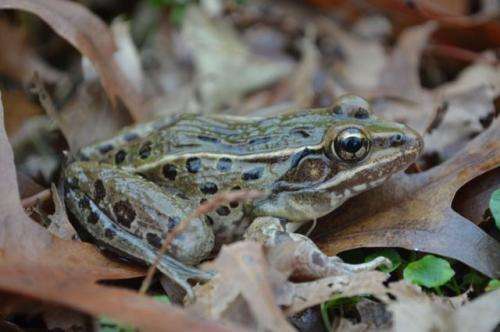NYC frog definitively identified as a new species

A team of scientists has resolved a nearly 80-year-old mystery surrounding a group of frogs in and around New York City known for their distinctively odd croak.
UCLA conservation biologist Brad Shaffer and other scientists have definitively identified the frog as a new species and named it Rana kauffeldi in honor of Carl Kauffeld, a curator at the Staten Island Zoo who became riveted by the frogs' peculiar "ribbit" in the 1930s.
In a paper published Oct. 29 in the journal PLOS ONE, Shaffer and colleagues from Rutgers University and other institutions provided the formal description needed to demonstrate that the frog is indeed a new species. The findings built on the researchers' work, published two years ago, presenting the genetic evidence that a previously unknown frog lived and bred within view of the Statue of Liberty.
The new paper presents the species' name for the first time and outlines concerns about the animal's conservation challenges, which are significant for a species in the urban eastern U.S. The paper also provides biological details including the frog's distinctive color (mint-gray to light olive-green with medium to dark spots), call (a short, repetitive croak) and geographic distribution.
Lead author Jeremy Feinberg, a Rutgers doctoral candidate, first encountered the frog six years ago on Staten Island. It didn't take long for him to pick up where Kauffeld left off. In 1937, Kauffeld noticed that the Atlantic Coast Leopard Frog, as it will now be commonly known, appeared to be different than the northern and southern leopard frog populations nearby, but he never formally presented his results to the scientific community.
"Kauffeld knew something was up," said co-author Shaffer, a professor in UCLA's department of ecology and evolutionary biology and director of the UCLA La Kretz Center for California Conservation Science. "This new species confirms Kauffeld's insight and has now launched a multi-state, multi-investigator effort to figure out the animal's range for conservation purposes."
The La Kretz Center will conduct genetics research to identify specimens as they are found. Genetic confirmation is needed because—as the tepid reception to Kauffeld's original work indicated—the frogs can be very difficult to tell apart.
"We had the benefits of genetic testing and bioacoustic analysis that simply weren't available to Kauffeld," Feinberg said in a Rutgers news release. "We wanted to acknowledge his work and give credit where we believe it was due even though it was nearly 80 years after the fact."
More information:
phys.org/news/2014-10-frog-inh … dor-connecticut.html
Provided by University of California, Los Angeles